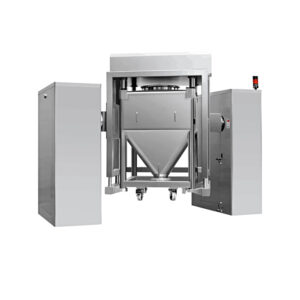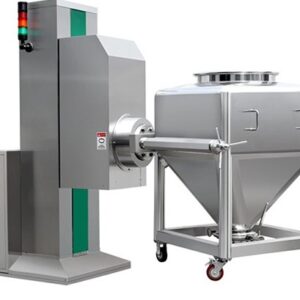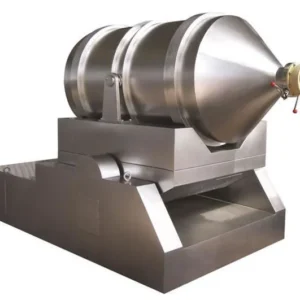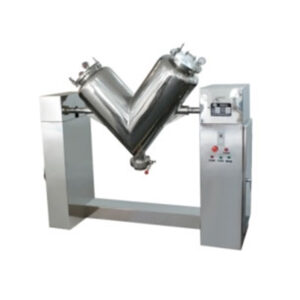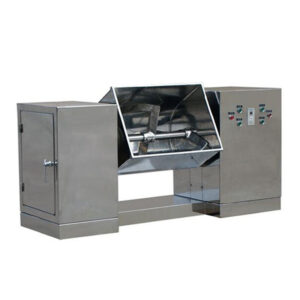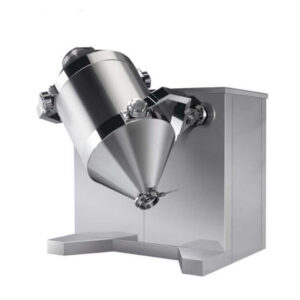Pharmaceutical Mixer
Qualipak’s Pharmaceutical Mixer is the last word on accuracy and efficiency in pharmaceutical blending. It has been fabricated using advanced technology to give it a homogeneity that meets the industry’s highest standards. Make your production process better with trustworthiness and regularity. Qualipak can help you improve your pharmaceutical manufacture.
Introduction of Pharmaceutical Mixer
The dynamic nature of pharmaceutical manufacturing has rendered precision and efficiency indispensable. In the middle of this sector is a vital part that guarantees the uniformity and quality of pharmaceuticals; it is called a mixer, which is used by pharmaceutical manufacturers to produce different drugs. These versatile machines have several uses including blending powders up to emulsifying liquids to make global medicines. This study will explore various aspects of mixers where we will look at types, the way they work, applications, functions as well as benefits with a look into the future trend regarding maintenance and training.
Understanding Pharmaceutical Mixers
- These mixers are designed for uniformizing blending or emulsionizing various components of drugs to get a homogenous product. For instance, these mixers are available in different types each specifically adapted to certain kinds of manufacturing processes.
-
Types of Pharmaceutical Mixers
- Tumbler Mixers: They also go by drum mixers and they usually use rotating drums for mixing pharmaceutical powders or granules. Tumblers are suitable for mixing large quantities of dry substances and thus commonly used at the first stages of manufacturing medicine
- Ribbon Blenders: Ribbon blenders have a unique double helix design which allows them to move materials in opposite directions leading to the perfect blending of powders and granules. This kind of mixer does not destroy delicate ingredients but blends gently hence applicable within the production process that requires gentle handling.
- Planetary Mixers: Planetary mixers are built with multi-bladed agitators that rotate enabling them to handle both solid and liquid constituents during mixing processes. At any given time, these can turn around multiple axes thus making them ideal for many purposes within pharmacy.
- High-Shear Mixers: Dispersion of powders through intense mechanical shearing forces as well as an emulsification technique for liquids characterizes high-shear mixing technology. The said devices can break down particles properly such that fine suspensions or emulsions occur; they are vital in formulating pharmaceutical preparations such as creams, ointments, and suspensions.
Fluid Bed Mixers: These mixers use a jet of air to fluidize and agitate particles so that efficient mixing and drying of pharmaceutical powders can occur. The machines control the temperature and humidity accurately which makes them appropriate for granulation/drying in single-step applications.
Working Process of Pharmaceutical Mixers
- The working process of pharmaceutical mixers varies depending on the type of mixer and the specific requirements of the formulation being produced. However, the general principle is about bringing together drugs under controlled conditions to achieve consistency and uniformity.
- For example, tumbler mixers work by gently tumbling powdered pharmaceuticals inside a rotating drum until they are uniformly mixed. In contrast, ribbon blenders use interlocking helical ribbons to ensure that ingredients are evenly distributed throughout. Planetary mixers rotate their agitators around thus ensuring blending between liquid particles as well as solid ones.
- On the other hand, high-shear mixers operate by subjecting ingredients to intense mechanical shearing forces which eventually lead to particle breakdown hence the formation of fine suspensions or emulsions. Fluid bed mixers fluidize and blend particles using airflow for one-step drying plus granulation because they can be regulated exactly as far as temperature and humidity are concerned.
Applications of Pharmaceutical Mixers
- These versatile systems can be used in almost all aspects of drug production across different enterprises within pharma industries. Some common applications include:
- Powder Blending: Pharmaceutical powders are mixed to create uniform mixtures of the active ingredients and additives, which ensure that they are consistent in dosage and efficacy.
- Granulation: This involves the agglomeration of powder particles into granules that improve flow properties, compressibility, and tablet manufacturing uniformity.
- Emulsification: High-shear mixers are used for emulsifying immiscible liquids to produce stable emulsions intended for creams, lotions, and suspensions among others.
- Drying: These dry fluid bed mixers; pass air through the fluidized bed to remove moisture from wet granules or powders ensuring product stability.
- Coating: Coatings may be applied on tablets or granules using some pharmaceutical mixers having this capability like functional coatings or protective coating.
Homogenization: In planetary mixers, ingredients can be homogenized completely to achieve no segregation resulting in a uniform distribution of their constituents throughout the final product.
Functions of Pharmaceutical Mixers
- Pharmaceutical mixers have several important roles in drug manufacturing such as:
- Uniform Mixing: To ensure that there is an even distribution of active ingredients and excipients within the formulation.
- Particle Size Reduction: Large particle sizes are reduced up to desirable particle size distributions required for end products by breaking them down.
- Emulsification: This involves facilitating liquid formulations to form stable emulsions through interaction with other substances like surfactants or other emulsifiers.
- Granulation: Powder particles are agglomerated using mechanical force to enhance their flowability and compressibility.
Drying: Moisture is removed from wet granules or powders enhancing its stability.
Maintenance and Training
-
Maintenance
- Routine check-up: Conduct scheduled visual inspections on the pharmaceutical mixer to help identify any wear, damage or contamination signs. Pay attention to vital parts like agitators, seals and bearings.
- Cleaning & Sanitization: Implement a strict cleaning & sanitization regime that eliminates cross-contamination while ensuring product integrity is maintained throughout. Use approved cleansers following standard operating procedures (SOPs) for thorough cleaning of all contact surfaces.
- Lubrication: Reduce friction in addition to preventing early wearing by ensuring that movable parts are properly lubricated. Stick to the manufacturer’s advice concerning the lubrication period plus use lubricants compatible with drugs.
- Calibration: Periodically calibrate instruments and control systems for accurate measurement and control of critical process parameters such as speed, temperature or pressure. Document calibration activities together with other equipment maintenance records.
- Repair/Replacement: Promptly repair or replace malfunctioned or identified problems through timely repair or replacement of bad components. Have an inventory with spare parts to minimize downtime while maintaining continuous operational capacity.
- Validation and Documentation: Validate equipment performance through periodic testing and verification of mixing parameters.
- Keep very detailed records showing all maintenance activity including inspections, repairs made plus calibration which prove adherence to regulatory requirements.
- Risk Assessment: Evaluate risks associated with the operation of pharmaceutical mixers and implement corrective measures aimed at protecting operators as well as equipment.
-
Training
- Operator Training: Provide comprehensive training to machine operators on safe operations while at the same time maintaining high levels of efficiency using machinery such as pharmaceutical mixers. Topics covered may include; setting up equipment, loading/unloading processes, process control mechanisms, problem-solving skills etc,
- Good Manufacturing Practices (GMP): Educate personnel on GMPs as well as other regulations governing pharmaceutical manufacturing. The teachings should sensitize individuals about the importance of hygiene, cleanliness and conformation to SOPs.
- Equipment Specific Training: Direct training programs to the kind of pharmaceutical mixer type and model in use to ensure that key features, operational parameters and maintenance needs unique to every equipment are given prominence.
- Safety Training: Enable operators to recognize possible dangers associated with the operation of pharmaceutical mixers and subsequently familiarize them with personal protective equipment (PPE). Safety measures such as emergency procedures, risk mitigations etc. will be presented as an antidote against accidents and injury.
- Quality Control and Assurance: Highlighting the critical factors behind product quality for staff members involved in quality control/assurance activities hence enlightening them on how pharmaceutical mixers help achieve uniformity from batch-to-batch processing.
- Continuing Education: Besides refresher courses and workshops; seminars on new developments in terms of technology applied during drug mixing in the pharmaceutical industry are recommended. Regulatory updates also form a good basis along with best practices related to both equipment maintenance and operation.
- Documentation and Record Keeping: Accurate documentation is paramount so that regulatory compliance may be maintained alongside enabling traceability of training activities plus qualifications.
FAQs
-
1. What is a pharmaceutical mixer?
- A pharmaceutical mixer refers to a special apparatus employed in blending, homogenization or emulsification of various formulations meant for making uniformity during the production of drugs.
-
2. What are the different types of pharmaceutical mixers?
- They include tumbler mixers; ribbon blenders; planetary mixers; high-shear mixers; and fluid bed mixers among others whose role varies with their types.
-
3. What is the working principle of pharmaceutical mixers?
- Various types of mixers have different principles of operation. Nevertheless, typical modes involve combining drugs in a controlled environment that ensures uniform blending, homogenization or emulsification.
-
4. What are the applications of pharmaceutical mixers?
- For several uses such as powder blending, granulation, emulsification drying coating and homogenization to produce various pharmaceutical preparations such as tablets, capsules, creams and suspensions.
-
5. What are the benefits of using pharmaceutical mixers?
- Advantages associated with using these devices include better product quality, increased efficiency, manufacturing flexibility improved safety and compliance with regulatory demands.
-
6. What are the future trends in pharmaceutical mixing technology?
- Advanced automation technology for future trends in drug mixing includes continuous manufacturing techniques to facilitate real-time monitoring &control systems while ensuring PAT integration into process analytical technology (PAT) protocols. This incorporates advancements in material science and mixing technologies.
-
7. How should pharmaceutical mixers be maintained?
- Pharmaceutical Mixers must be regularly inspected cleaned lubricated calibrated and repaired as required. Maintenance activities should be documented and risk assessments carried out for safe and efficient operations.
-
8. What training is required for operating pharmaceutical mixers?
- Operators of these machines should undergo extensive equipment training on GMP requirements and presently acceptable practices within his or her industry safety measures procedures about quality control and maintenance issues. it also needs regular continuing education programs to be documented during training activities done by staff.
-
9. How can pharmaceutical mixers contribute to product quality?
- These make sure that any active ingredients are uniformly blended into even quantities throughout a batch thus achieving accurate control over process parameters which would maintain the highest standards of quality leading to uniform products in terms of potency and efficacy.
-
10. What are the considerations for selecting a pharmaceutical mixer?
- The type of formulation to use cost capacity scalability regulatory compliance matters along with budget constraints among others. Professional consultation plus carrying out experiments could provide guiding information before final decision-making.

